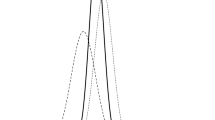Summary
The theory of pivotal inference applies when parameters are defined by reference to their effect on observations rather than their effect on distributions. It is shown that pivotal inference embraces both Bayesian and frequentist reasoning.
Similar content being viewed by others
References in the Discussion
BOOLE, G. (1854).An Investigation in the Laws ofThought. New York: Dover.
CROOK, J.F. and GOOD, I.J. (1980). On the application of symmetric Dirichlet distributions and their mixtures to contingency tables, Part. II.Ann Statist. (in press).
DICKEY, J.B. (1976). Approximate posterior distributions.J. Amer. Statist. Assoc. 71, 680–689.
DICKEY, J.M. (1977). Is the tail area useful as an approximate Bayes factor?.J. Amer. Statist. Assoc. 72, 138–142.
EFRON, B. and MORRIS, C. (1973). Combining possibly related estimation problems (with discussion).J. Roy. Statist. Soc. B 35, 379–421.
ERICSON, W. A. (1969). Subjective Bayesian models in sampling finite populations (with discussion).J. Roy. Statist. Soc. B 31, 195–233.
GOOD, I.J. (1950).Probability and the Weighing of Evidence. London: Griffin, New York: Hafner.
— (1967). A Bayesian significance test for multinomial distributions.J. Roy. Statist. Soc. B 29, 399–431. (with discussion). Corrigendum36 (1974), 109.
— (1976a). The Bayesian influence, or how to sweep subjectivism under the carpet.Foundations of Probability Theory, Statistical Inference, and Statistical Theories of Science. (C.A. Hooker and W. Harper ed.), Vol. 2, 125–174, Holland: D. Reidel.
— (1976b) On the application of symmetric Dirichlet distributions and their mixtures to contingency tables.Ann. Statist. 4, 1159–1189.
GOOD, I.J. and CROOK, J.F. (1974). The Bayes/non-Bayes compromise and the multinomial distribution.J. Amer. Statist. Assoc. 69, 711–720.
HOERL, A.E. and KENNARD, R.W. (1970). Ridge regression: biased estimation for nonorthogonal problems.Technometrics 12, 55–67.
KADANE, J.B., LEWIS, G.H. and RAMAGE, J.G. (1969). Horvarth’s theory of participation in group discussion.Sociometry 32, 348–361.
KADANE, J.B. and DICKEY, J.M. (1980). Bayesian decision theory and the simplification of models.Evaluation of Econometric Models. (J. Kmenta and J. Ramseyu, eds) New York: Academic Press.
LINDLEY, D.V. and SMITH, A.F.M. (1972). Bayes estimates for the linear model (with discussion).J. Roy. Statist. Soc. B 34, 1–41.
VON MISES, R. (1942). On the correct use of Bayes’ formula.Ann. Math. Statist. 13, 156–165.




